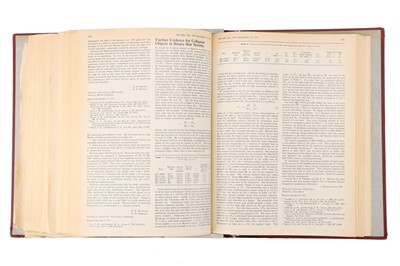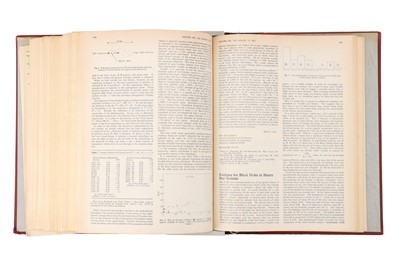24th May, 2023 12:00
Fine Instruments of Science, Medicine and Books
2 Important Articles on Black Holes by Stephen Hawking, Nature
comprising of:
1 - Nature A Weekly Journal of Science, Volume 232, August 13, 1971, London, Macmillan Journals, Ltd, complete bound journals, with library stamps throughout for 'Strangeways Research Laboratory Library, Cambridge'with first edition, first impression of Stephen Hawking and G. W Gibbon's paper: Evidence for Black Holes in Binary Star Systems [p.465 – p.466]
In 1971, two physicists, C. H. Gibbons and M. R. H. Hawkins, published an article in the journal Nature titled "Evidence for Black Holes in Binary Star Systems." This article presented compelling evidence for the existence of black holes, which until then had only been a theoretical concept.
Gibbons and Hawkins focused on the behavior of binary star systems, which consist of two stars that orbit around a common center of mass. By measuring the velocities and positions of the stars over time, they were able to calculate the masses of the stars and their distance from each other. They found that in some cases, one of the stars appeared to be much more massive than expected, indicating that it might be a black hole.
The evidence for the presence of a black hole in these binary systems comes from the fact that the observed star's mass is much larger than that of any known star. Additionally, the black hole cannot be seen directly, as it does not emit any light. However, its presence can be inferred from the gravitational effects it has on its companion star.
One of the most convincing pieces of evidence presented by Gibbons and Hawkins was the behavior of a binary system called Cygnus X-1. This system consists of a massive star and an invisible companion. By measuring the orbit of the visible star, the researchers were able to calculate the mass of the invisible companion, which turned out to be around 10 times the mass of the sun. Such a massive object cannot be a normal star, leading them to conclude that it must be a black hole.
Gibbons and Hawkins' article was groundbreaking in its time, as it provided the first observational evidence for the existence of black holes. Since then, many more black holes have been discovered, and they are now believed to be a common feature of the universe. Black holes are thought to play a crucial role in the formation of galaxies, and they are now a major focus of research in astrophysics.
In conclusion, Gibbons and Hawkins' article "Evidence for Black Holes in Binary Star Systems" presented convincing evidence for the existence of black holes in binary systems. Their observations provided strong support for a theoretical concept that had until then been purely hypothetical. The discovery of black holes has had a significant impact on our understanding of the universe, and their study continues to be a major area of research in astrophysics.
and
2 - Nature A Weekly Journal of Science, Volume 234, No. 5328, December 10, London, Macmillan Journals, Ltd, complete bound journals, with library stamps throughout for 'Strangeways Research Laboratory Library, Cambridge'with first edition, first impression of Dr. Stephen Hawking and Dr. G W Gibbons reply to A. H Batten & R.P. Olowins letter to Nature titled Black Holes & Binary Stars [p.341 – p.342]
The article by Batten, Olowin, Hawking, and Gibbons was one of the first to explore the possibility that black holes could be formed through the evolution of binary star systems. The authors proposed a new mechanism for the formation of black holes that involved the transfer of matter between two stars in a binary system.
The idea behind the article was that when two stars are in a binary system, they are in close proximity to one another, and their gravitational fields can interact in such a way as to cause one star to transfer material to the other. If one of the stars is sufficiently massive, it can accrete a large amount of matter from its companion, eventually becoming so massive that it collapses in on itself, forming a black hole.
The authors used a combination of theoretical calculations and observational data to support their hypothesis. They showed that if two stars in a binary system were close enough together, they could transfer enough matter to cause one of them to collapse into a black hole. They also noted that there were several binary star systems in our own galaxy that were likely candidates for this process.
The article was groundbreaking for several reasons. First, it provided a new mechanism for the formation of black holes, which had previously been thought to form only from the collapse of massive stars. Second, it showed that binary star systems could be important for understanding the evolution of stars and the formation of black holes. Third, it demonstrated the power of combining theoretical calculations with observational data to develop new ideas in astrophysics.
The work of Batten, Olowin, Hawking, and Gibbons has had a significant impact on our understanding of black holes and binary star systems. Today, astronomers continue to study these objects, using new telescopes and advanced theoretical models to explore their properties and evolution. The article 'Black Holes and Binary Stars' remains an important landmark in the history of astrophysics, and a testament to the power of collaboration and interdisciplinary research.
Stephen Hawking (1942-2018) was a celebrated physicist, cosmologist, and author. He was born in Oxford, England, and after receiving his Ph.D. from Cambridge University, he went on to become a world-renowned researcher and professor. Hawking's work on black holes, quantum mechanics, and the origins of the universe has had a profound impact on our understanding of the cosmos. Despite being diagnosed with ALS (amyotrophic lateral sclerosis) at the age of 21, Hawking continued to make significant contributions to the fields of physics and cosmology throughout his lifetime. He was the author of several popular science books, including "A Brief History of Time," which has sold millions of copies worldwide. Hawking's legacy as a brilliant thinker and communicator of science continues to inspire and educate people around the world.
Sold for £600
Result including buyers premium
comprising of:
1 - Nature A Weekly Journal of Science, Volume 232, August 13, 1971, London, Macmillan Journals, Ltd, complete bound journals, with library stamps throughout for 'Strangeways Research Laboratory Library, Cambridge'with first edition, first impression of Stephen Hawking and G. W Gibbon's paper: Evidence for Black Holes in Binary Star Systems [p.465 – p.466]
In 1971, two physicists, C. H. Gibbons and M. R. H. Hawkins, published an article in the journal Nature titled "Evidence for Black Holes in Binary Star Systems." This article presented compelling evidence for the existence of black holes, which until then had only been a theoretical concept.
Gibbons and Hawkins focused on the behavior of binary star systems, which consist of two stars that orbit around a common center of mass. By measuring the velocities and positions of the stars over time, they were able to calculate the masses of the stars and their distance from each other. They found that in some cases, one of the stars appeared to be much more massive than expected, indicating that it might be a black hole.
The evidence for the presence of a black hole in these binary systems comes from the fact that the observed star's mass is much larger than that of any known star. Additionally, the black hole cannot be seen directly, as it does not emit any light. However, its presence can be inferred from the gravitational effects it has on its companion star.
One of the most convincing pieces of evidence presented by Gibbons and Hawkins was the behavior of a binary system called Cygnus X-1. This system consists of a massive star and an invisible companion. By measuring the orbit of the visible star, the researchers were able to calculate the mass of the invisible companion, which turned out to be around 10 times the mass of the sun. Such a massive object cannot be a normal star, leading them to conclude that it must be a black hole.
Gibbons and Hawkins' article was groundbreaking in its time, as it provided the first observational evidence for the existence of black holes. Since then, many more black holes have been discovered, and they are now believed to be a common feature of the universe. Black holes are thought to play a crucial role in the formation of galaxies, and they are now a major focus of research in astrophysics.
In conclusion, Gibbons and Hawkins' article "Evidence for Black Holes in Binary Star Systems" presented convincing evidence for the existence of black holes in binary systems. Their observations provided strong support for a theoretical concept that had until then been purely hypothetical. The discovery of black holes has had a significant impact on our understanding of the universe, and their study continues to be a major area of research in astrophysics.
and
2 - Nature A Weekly Journal of Science, Volume 234, No. 5328, December 10, London, Macmillan Journals, Ltd, complete bound journals, with library stamps throughout for 'Strangeways Research Laboratory Library, Cambridge'with first edition, first impression of Dr. Stephen Hawking and Dr. G W Gibbons reply to A. H Batten & R.P. Olowins letter to Nature titled Black Holes & Binary Stars [p.341 – p.342]
The article by Batten, Olowin, Hawking, and Gibbons was one of the first to explore the possibility that black holes could be formed through the evolution of binary star systems. The authors proposed a new mechanism for the formation of black holes that involved the transfer of matter between two stars in a binary system.
The idea behind the article was that when two stars are in a binary system, they are in close proximity to one another, and their gravitational fields can interact in such a way as to cause one star to transfer material to the other. If one of the stars is sufficiently massive, it can accrete a large amount of matter from its companion, eventually becoming so massive that it collapses in on itself, forming a black hole.
The authors used a combination of theoretical calculations and observational data to support their hypothesis. They showed that if two stars in a binary system were close enough together, they could transfer enough matter to cause one of them to collapse into a black hole. They also noted that there were several binary star systems in our own galaxy that were likely candidates for this process.
The article was groundbreaking for several reasons. First, it provided a new mechanism for the formation of black holes, which had previously been thought to form only from the collapse of massive stars. Second, it showed that binary star systems could be important for understanding the evolution of stars and the formation of black holes. Third, it demonstrated the power of combining theoretical calculations with observational data to develop new ideas in astrophysics.
The work of Batten, Olowin, Hawking, and Gibbons has had a significant impact on our understanding of black holes and binary star systems. Today, astronomers continue to study these objects, using new telescopes and advanced theoretical models to explore their properties and evolution. The article 'Black Holes and Binary Stars' remains an important landmark in the history of astrophysics, and a testament to the power of collaboration and interdisciplinary research.
Stephen Hawking (1942-2018) was a celebrated physicist, cosmologist, and author. He was born in Oxford, England, and after receiving his Ph.D. from Cambridge University, he went on to become a world-renowned researcher and professor. Hawking's work on black holes, quantum mechanics, and the origins of the universe has had a profound impact on our understanding of the cosmos. Despite being diagnosed with ALS (amyotrophic lateral sclerosis) at the age of 21, Hawking continued to make significant contributions to the fields of physics and cosmology throughout his lifetime. He was the author of several popular science books, including "A Brief History of Time," which has sold millions of copies worldwide. Hawking's legacy as a brilliant thinker and communicator of science continues to inspire and educate people around the world.





